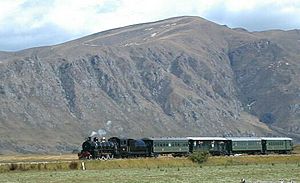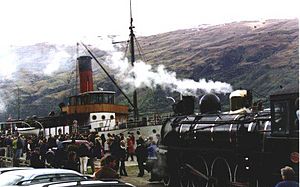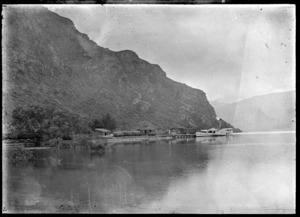Kingston Flyer facts for kids
Quick facts for kids Kingston Flyer |
|
|---|---|

The Kingston Flyer approaching the terminus at Fairlight, December 2000
|
|
| Locale | |
| Terminus | Kingston |
| Commercial operations | |
| Name | Kingston Branch |
| Built by | Southland Provincial Council (to 1870) Otago Provincial Council (1870–1876) Department of Public Works (1877–1878) |
| Original gauge | 3 ft 6 in (1,067 mm) |
| Preserved operations | |
| Stations | 2 |
| Length | 13.69 kilometres (8.51 mi) |
| Preserved gauge | 3 ft 6 in (1,067 mm) |
| Commercial history | |
| 1886 | Kingston Flyer name first used for train between Gore and Kingston after nationalisation of the Waimea Plains Railway. |
| 4 October 1937 | End of regular passenger services. |
| 1957 or 1958 | End of holiday season passenger services. |
| 21 December 1971 | Re-opened to summer season vintage trains. |
| Closed to passengers | 17 April 1979 |
| Closed | 25 November 1979 |
| Preservation history | |
| 18 December 1982 | Kingston – Fairlight re-opened to summer season vintage trains. |
| 1 December 1992 | Operation sold to New Zealand Rail Limited |
| 2011 | Operation sold to private owner, David Bryce. Services restarted after a two-year lay up. |
The Kingston Flyer is a special old steam train in the South Island of New Zealand. It runs near the bottom of Lake Wakatipu. This train uses 14 kilometres of old railway track. This track used to be part of the Kingston Branch railway line.
The Kingston Flyer was first a passenger express train. It traveled between Kingston, Gore, Invercargill, and sometimes Dunedin. The New Zealand Railways (NZR) ran it from the 1890s until 1957. In 1971, NZR brought the train back as a fun tourist ride. Later, in 1982, they let a private company run it. The Kingston Flyer has had a few different owners since then. Now, a group of volunteers is working to fix the railway and trains. They hope to start the services again soon.
Contents
History of the Kingston Flyer

The Kingston Flyer started running in the late 1890s. This was when New Zealand was getting better after a tough economic time. Before the Flyer, slow trains carried both people and goods. These "mixed trains" ran on the Kingston Branch and Waimea Plains Railway.
As the economy improved, the Railways Department wanted more train services. The government bought the Waimea Plains Railway. They made it part of the country's main railway system. The Kingston Branch went north and south between Invercargill and Kingston. The Waimea Plains Railway branched off in Lumsden. It went east to meet the main line in Gore.
More mixed trains started running. Special passenger trains were also added. These passenger trains became known as the Kingston Flyer. This name was especially used for the trains between Gore and Kingston.
The Flyer went to Kingston every weekday. On some days, it went from Kingston to Gore. There, it connected with other express trains. On other days, it went from Kingston to Invercargill.
In the early years, the trains were usually pulled by K and V class steam locomotives. During busy holidays like Christmas, extra trains were needed. Some trains even came all the way from Dunedin to Kingston. In Kingston, people could get on Lake Wakatipu steamboats. These boats took them to the popular holiday spot of Queenstown. For many years, this was the main way to travel to Queenstown.
Why the Flyer Stopped Running
In the 1930s, fewer people rode the train. The Railways Department decided to stop the services on the Kingston Branch. This happened on October 4, 1937. This was the end of the regular Kingston Flyers.
A shorter service continued to run until 1945. Then, buses run by the New Zealand Railways Road Services took over the train routes.
However, this was not the complete end of the Flyers. The train schedules still listed a "runs as required" Kingston Flyer. This train usually ran during peak holiday times. It went between Gore (and sometimes Dunedin) to Kingston. For many years, these special trains worked with the Lake Wakatipu steamers. They helped people get to Queenstown.
At first, many people used these holiday trains. But by the 1950s, fewer and fewer people rode them. The last Kingston Flyer ran during the Easter holidays in 1957.
Bringing the Flyer Back to Life
In 1971, New Zealand Railways announced a plan. They would bring back the Kingston Flyer as a special heritage service. The last regular steam train service in New Zealand ended in October 1971. The new Kingston Flyer started just two months later, on December 21.
It ran on the part of the Kingston Branch between Lumsden and Kingston. It became very popular! From 1971 to 1979, it ran every summer until Easter. More than 30,000 people rode it each year.
In 1979, floods damaged the railway line. The last Kingston to Invercargill Flyer ran on April 17, 1979. The damaged part of the track was officially closed in November that year. For the next three years, the Kingston Flyer ran on different routes.
In 1982, NZR brought the Kingston Flyer back to Kingston. The plan was to use 20 kilometres of track. But they decided to end the line in Fairlight instead. So, an extra six kilometres of track were closed.
The original Flyers used K and V class locomotives. But for the new Kingston Flyer, two AB class steam locomotives were fixed up. These were AB 778 and AB 795.
The Kingston Flyer usually ran for seven months of the year. It ran from October 1 to April 30. Two trains ran every day, except for Christmas Day.
In 1992, the company that took over NZR bought Kingston Flyer Limited. Then, in 2003, it was sold again to a private owner.
Challenges and Changes (2009-2018)
In 2008, the Kingston Flyer was put up for sale. It faced money problems. In 2009, it was announced that the train would stop running for a while. This was because of growing debts.
A company tried to buy the train, but the owners wanted more money. A local group tried to raise money to save the Flyer. But they couldn't get enough funds. In November 2009, the Flyer's owners went into a difficult financial situation. The train was put up for sale again.
In 2011, the business was listed for sale online. It included the trains, land, and stations. A businessman named David Bryce bought it in August 2011. He got the train running again on October 29, 2011.
In December 2012, the Kingston Flyer stopped again. One of the locomotives, AB 778, had leaks in its boiler. Also, the owner, David Bryce, had health problems. The train was supposed to start again after AB 795 was fixed. The business was put up for sale once more. By December 2013, it was still not sold. The owner thought about putting it into a special trust.
In 2017, it was announced that the Kingston Flyer and its land were sold. The buyers seemed more interested in the land than the train. Another group thought about buying the train to run it elsewhere. But in December 2017, it was decided the train would stay in Kingston. People hoped one locomotive would be ready by February 2018.
In early 2018, there were reports that the new owners had "big plans" for the train. By the end of 2018, a new operator planned to restart the service within a year.
What's Happening Now
At the start of 2020, people hoped the train would be back in service that year. In May 2020, the new owners said they wanted to restore the service by Summer 2020. In January 2021, the company asked for permission to run trains again. But they said they didn't know exactly when it would happen. In April 2021, the Kingston Flyer did run trains as part of a special tour.
Locomotives and Carriages
Since 1971, the Kingston Flyer has mainly used two AB class steam locomotives:
- AB 778: This train started working in 1925.
- AB 795: This train started working in 1927. It even pulled the New Zealand Royal Train once!
From 2000 to 2003, another old locomotive, K 92, was based in Kingston. This K class engine was like the ones that pulled the original Flyers. It ran services by itself and with the AB engines. K 92 later moved to Mandeville.
The Flyer also has a small shunting locomotive called TR 350. This is a 15-tonne diesel engine. It is used to move carriages around at Kingston. It also helps with work trains when the main service is closed for winter.
When the heritage Flyer started in 1971, it had seven wooden passenger carriages:
| Number | TMS Number | Builder | Year built | Carriage type |
|---|---|---|---|---|
| A 595 | A 50702 | NZR Addington | 1900 | 47' 6" 'Birdcage' gallery coach |
| A 1255 | A 50729 | NZR Addington | 1913 | 47' 6" passenger coach |
| A 1518 | A 50737 | NZR Addington | 1923 | 47' 6" passenger coach |
| A 1521 | A 50745 | NZR Addington | 1923 | 47' 6" passenger coach |
| AA 1132 | A 50710 | NZR Petone | 1919 | 47' 6" passenger/refreshments coach |
| AF 950 | AF 35 | NZR Hillside | 1906 | 47' 6" car-van |
| AF 1172 | AF 41 | NZR Addington | 1911 | 47' 6" car-van |
In 1999, an eighth carriage was added. This was a 56-foot steel passenger carriage (A 1958). It was a newer type of carriage. It was the only new carriage added since 1971. This carriage was sold in 2015. You can now see it on Huntingdon Street.
The Flyer also has a few goods wagons. These include wagons for ballast (stones for the track) and a plough van. Most of these wagons are used for maintaining the railway. Three flat wagons are used at the Kingston train depot. They help hold parts for the locomotives.


